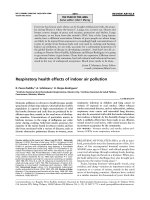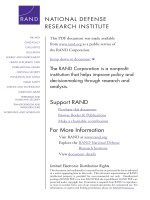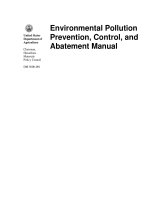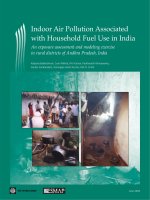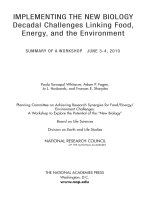Addressing the Links between Indoor Air Pollution, Household Energy and Human Health potx
Bạn đang xem bản rút gọn của tài liệu. Xem và tải ngay bản đầy đủ của tài liệu tại đây (735.89 KB, 56 trang )
Addressing the Links
between Indoor Air Pollution,
Household Energy
and Human Health
Based on the WHO-USAID
Global Consultation
on the Health Impact of Indoor Air Pollution
and Household Energy in Developing Countries
(Meeting report)
Washington, DC
3-4 May 2000
WHO/HDE/HID/02.10
Original: English
Distr.: Limited
World Health Organization
Copyright © World Health Organization 2002
This document is not issued to the general public, and all rights are reserved by the World Health
Organization (WHO). The document may not be reviewed, abstracted, quoted, reproduced or translated, in
part or in whole, without the prior written permission of WHO. No part of this document may be stored in a
retrieval system or transmitted in any form or by any means - electronic, mechanical or other - without the
prior written permission of WHO.
The views expressed in this document by named authors are solely the responsibility of those authors.For further information contact:
Dr Yasmin von Schirnding
Focal Point: Agenda 21
World Health Organization
1211 Geneva 27, Switzerland
Telephone: +41 22 791 35 33
Fax: +41 22 791 41 53
e-mail:
World Health Organization
Addressing the Links
between Indoor Air Pollution,
Household Energy
and Human Health
Based on the WHO-USAID
Global Consultation
on the Health Impact of Indoor Air Pollution
and Household Energy in Developing Countries
(Meeting report)
Washington, DC
3-4 May 2000
World Health Organization
Report from Washington Consultation
|
3
Table of Contents
Preface
page: 5
Introduction page: 7
1
|
Household Energy and Development page: 11
What Household Fuels Are Being Used Today?
Why Indoor Air Pollution is Bad for Health?
Quality of Life in the Home
Household Fuel as a Key Issue for Women
The Wider Environmental Impact
Deforestation and fuel supply
Contribution to greenhouse gases
Poverty Makes it Worse
Summary
Case Study 1
2
|
The Health Burden of Indoor Air Pollution Exposure page: 17
Levels of Smoke Pollution
What Should We Be Measuring?
Case Study 2
Health Effects of Exposure to Indoor Air Pollution
Conditions for which Evidence is Quite Strong
Conditions for which Evidence is Tentative
Shortcomings of Studies
What Does the Evidence Tell Us?
Indoor Air Pollution and the Global Burden of Disease
What Further Health Research is Needed?
What Can We Now Conclude?
3
|
Economic Evaluation of Household Energy Interventions page: 23
Working Out the Costs and Benefits
Is Intervening Cost-effective?
What Else Do We Need to Know?
4
|
Towards Effective and Sustainable Interventions page: 27
Lessons from Past Experience
Selecting the Right Intervention
Interventions on the source of pollution
Interventions to the living environment
Interventions to user behaviours
Case Study 3
Getting Results: the Importance of Supportive Policies
Making it work on the ground
Why international and national policies are vital
Money matters
Case Study 4
Is Sustainable Intervention Possible?
5
|
The Way Forward page: 35
Why Global Action is Worth It
Getting More Countries Involved
Working Together: the Need for Collaborative Action
6
|
Recommendations page: 39
Policy and Strategy Recommendations
Research Recommendations
Final Conclusions
|
List of Acronyms Used page: 43
|
Annex 1: Background of the Meeting page: 44
|
Annex 2: List of Participants page: 45
4
|
Addressing the Links between Indoor Air Pollution, Household Energy and Human Health
Report from Washington Consultation
|
5
Preface
Household energy and indoor air pollution pose a substantial threat to the health of the
world’s poor. Although there are gaps in our knowledge of the health risks and the most
effective interventions and appropriate policies at international, national and local levels,
there is enough evidence to justify action now. This report is based on a WHO/USAID
Global Consultation on the Health Impact of Indoor Air Pollution and Household Energy in
Developing Countries (Washington DC, 3-4 May 2000). It is aimed at a general audience
interested in household energy, indoor air and health issues. A companian technical report
based in part on the meeting’s deliberations was prepared for the Comission on
Macroeconomics and Health, and can be consulted for further information and reference
material
(1)
. The report sets out the rationale for action, and the priority research and policy
interventions that can help achieve this goal are discussed. The context in which household
energy is used is highlighted, as well as the impact on everyday life and prospects for
development. Attention is then given to the evidence we now have on the risks to health
arising from exposure of women and young children to smoke in the home, and the overall
significance of this for the health of populations in poor countries. Potential economic ben-
efits, options for interventions, together with approaches to assessing effectiveness and
suitability, are subsequently considered. Finally, recommendations are made for concerted
action to help bring about substantial improvements in the situation for poor communities.
Acknowledgements
• Preparation of the text (based on the report of the WHO/USAID meeting):
Nigel Bruce (University of Liverpool, UK) and Yasmin von Schirnding (WHO).
• Text editor: Joanna Trevelyan.
• Photographs: compliments of Nigel Bruce.
• The former Departments of Child and Adolescent Health and Development (CAH),
Health and Sustainable Development (HSD), and USAID are thanked for their support.
Addressing the Links between Indoor Air Pollution, Household Energy and Human Health
Report from Washington Consultation
(1) WHO. Addressing the Impact of Household Energy and Indoor Air Pollution on the Health of the Poor:
Implications for Policy Action and Intervention Measures. Geneva, World Health Organization, 2002
(WHO/HDE/HID/02.9).
Poverty remains the greatest barrier to reducing the enormous global inequalities in
health that still exist, and which in some countries are worsening. A hitherto neglected
factor, which is both a cause and a result of poverty, is the continuing dependence of
almost half of the world’s population on polluting and inefficient household fuels and
appliances. Household energy impacts on the health of the poor through a variety of
physical, social and economic routes, but the most important direct health impact
results from indoor air pollution (IAP) produced by burning biomass fuels (wood,
dung, crop wastes) and coal in simple stoves with inadequate ventilation.
Until quite recently, there has been inadequate official recognition of the size
and extent of the problem and little effective action. This is despite a number of key
publications, meetings and other activities over the past 15 years (see box below).
Addressing the Links between Indoor Air Pollution, Household Energy and Human Health
Report from Washington Consultation
|
7
Tackling indoor air pollution: examples of key activities to date
• ‘Biofuels, Air Pollution and Health: a Global Review’, presented the first comprehensive account
of biomass use, pollution levels, health effects and interventions.
(1)
• WHO Consultation (1991) held in Geneva, and associated Report, reviewed the current
situation and action needed.
(2)
• The 1992 World Development Report identified indoor air pollution as ‘one of the four most
critical global environmental problems’. The 1993 Report, ‘Investing in Health’ noted that
‘rural people in developing countries may receive as much as two-thirds of the global
exposure to particulates’, and listed the main diseases associated with this exposure.
(3)
• The 1997 UNDP report, ‘Energy after Rio’ provided a broad ranging review that recognised
the links between energy, health and sustainable development. Biomass use, health effects
and strategies for change were examined.
(4)
• The 2000 WHO/USAID Global Consultation on the Health Impact of Indoor Air Pollution and
Household Energy in Developing Countries, held in Washington DC.
• The 2000 UNDP/UNDESA/WEC World Energy Assessment report: “Energy and the Challenge
of Sustainability” which highlighted the problem of household energy and human health.
(5)
(1) Smith KR. Biofuels, air pollution, and health. A global review. New York, Plenum Press, 1987.
(2) WHO. Indoor air pollution from biomass fuel. Working papers from a WHO consultation,
June 1991. Geneva, World Health Organization, 1992.
(3) World Bank. Investing in health. World Development Report. New York, Oxford University Press,
1993.
(4) Reddy A, Williams R, Johansson T. Energy after Rio: prospects and challenges. New York,
United Nations Development Programme, 1997.
(5) UNDP/UNDESA/WEC. World Energy Assessment: Energy and the challenge of sustainability.
New York, United Nations Development Programme, 2000.
(6) A confounding factor is one that might also account for the poor health outcomes that are being attributed to
IAP, such as malnutrition.
Over the last 30 years or so, work has been carried
out in the field of household energy by a wide
range of research groups, NGOs, and some inter-
national agencies. Much of this activity however
was project based, often donor-led, and mainly
focused on reducing fuel use, cutting costs to
households and protecting the environment from
deforestation and erosion. There has been aware-
ness of the connections with health, but in practice
this has not been prominent. In addition, very little
of this work was co-ordinated, and as a result did
not bring about substantial change in policy, donor
commitment or - most important - action in those
countries and poor communities worst affected.
Where We Are Today
Recent estimates indicate that around three billion people are still primarily dependent on
biomass fuels and coal for their everyday household energy needs, including up to 80-90%
in some countries of sub-Saharan Africa. The overall use of biomass fuel is not falling, and
indeed continues to increase among the poorest people who also are turning to cruder forms
of biomass, and other waste, to use as fuel.
Evidence on the health effects of indoor air pollution has grown in the last 10 years, and there is
now fairly good evidence that exposure increases the risk of acute lower respiratory infections
(ALRI) in children, chronic obstructive lung disease (COPD) in adults, and lung cancer where
coal is used extensively. In addition, evidence is now emerging of links with a number of other
conditions, including tuberculosis, perinatal mortality (stillbirths and deaths in the first week of
life), low birth weight, asthma, otitis media, cancer of the upper airway, and cataracts. Although
there is now more evidence, it is still deficient in a number of important respects, including
imprecise measurement of levels of exposure to pollution, inconsistent definitions of health
outcomes, and inadequate attention paid to the influence of other ‘confounding’ factors
(6)
. The
implication of these limitations is that, although we can be fairly confident that IAP does increase
the risk of a number of conditions such as ALRI, we cannot be yet sure by how much.
It is estimated that IAP is responsible for nearly two million deaths annually in developing coun-
tries and around 4% of the burden of disease (expressed as DALYs – disability adjusted life years).
In addition to these direct effects of IAP on health, are other consequences arising from the use
of household energy in conditions of poverty. These include burns to children falling onto open
fires, ingestion of kerosene stored in soft drinks containers, restrictions on income generating
activity, the opportunity costs for women of spending many hours collecting wood fuel as this
becomes increasingly scarce, as well as injuries arising from carrying heavy loads and collecting
fuel in areas where there is a risk of violence.
8
|
Addressing the Links between Indoor Air Pollution, Household Energy and Human Health
Report from Washington Consultation
Around three billion people are still primarily
dependent on biomass fuels and coal for their
everyday household energy needs.
A wide range of interventions are capable of contributing to a reduction in indoor air pollution.
These include interventions at the source of pollution (improved stoves with cleaner fuels), to
the living environment (better ventilation); and to user behaviour (use of pot lids, keeping
children away from smoke). For any intervention to be successfully implemented, it should be
locally appropriate, and sustainable in the market. Full participation of local people (especially
women), appropriate financial support (e.g. micro-credit, avoidance of subsidies), inter-sectoral
collaboration at local and national levels, and energy policies that support rather than hinder
access by the poor to cleaner fuels, are also important. There is an urgent need to consolidate
experience of interventions to date, encourage the evaluation of future interventions in a
systematic and comparable way, build capacity in countries, and promote the dissemination of
experience in ways that are accessible locally and internationally.
Initial work on assessing the economic costs and benefits of interventions in household
energy are encouraging. For example, the cost per DALY saved of an improved stove may be
in the range US$ 50-100, comparing favourably with other important health interventions.
However, more research is needed to quantify the relationship between exposure and risk of
disease, and the health gains resulting from measured reductions in exposure.
There is now greater awareness of the inter-relationships between household energy, health
and poverty. Poverty is a barrier in the transition to modern fuels, while reliance on such
fuels holds back development due to the health burden, and the loss of time and opportunities
for economic development.
Addressing the Links between Indoor Air Pollution, Household Energy and Human Health
Report from Washington Consultation
|
9
|
Household Energy and Development – an Overview of the Issues
What Household Fuels Are Being Used Today?
Estimates suggest that wood provides around 15% of energy needs in developing countries,
rising to 75% in tropical Africa. In more than 30 countries, wood still provides more than
70% of energy, and in 13 countries it is over 90%. Moreover, as the prices of alternatives
such as kerosene and bottled gas have increased, the use of biomass fuels has increased.
With development there is generally a transition up the so-called ‘energy-ladder’ (Figure 1.1),
towards fuels which are progressively more efficient, cleaner, convenient and expensive.
Households typically use a combination of fuels, for example wood for cooking and heating,
and kerosene or electricity for lighting, so it is not a simple linear progression. However,
households do tend to carry out more tasks with more modern fuels as their socio-economic
circumstances improve. The problem is that almost half of the world’s population relies pre-
dominantly on fuels towards the lower end of this energy ladder, and for many the prospects
of moving up it in the short term appear limited.
Why Indoor Air Pollution is Bad for Health
Households reliant on biomass and coal generally use the fuel indoors, in open fires or
poorly functioning stoves, and usually with inadequate venting of smoke. The smoke from
biomass fuel and coal contains a large number of pollutants that are dangerous to health,
including small particles, carbon monoxide, nitrogen dioxide, sulphur dioxide (this mainly
from coal), formaldehyde, and carcinogens such as benzo[a]pyrene and benzene. Studies
from Asia, Africa and the Americas have shown that indoor air pollution levels in these
homes are extremely high, many times the limits set by the U.S. Environmental Protection
Agency (EPA) and WHO. The most important impacts appear to be on acute respiratory
infections in children, and chronic lung disease in adults, and in developing countries the
overall public health impact of IAP is substantial.
Addressing the Links between Indoor Air Pollution, Household Energy and Human Health
Report from Washington Consultation
|
11
Figure 1.1. The energy ladder: in practice, most
households use a combination of fuels, and this mix
shifts as prosperity increases.
Biomass will remain the principal household fuel for
the poor for many years to come.
LPG. Gas
Kerosene
Charcoal
Wood
Crop waste
Increasing cleanless, efficiency, cost, convenience
Increasing prosperity
Electricity
Quality of Life in the Home
For the majority of poor people, the fire, or hearth, is at the centre of home life. It provides
the energy required for cooking, warmth and light, and is very often the focal point of the
home with important cultural and spiritual significance. Although smoke is recognised as a
nuisance, causing sore, running eyes, coughs and headaches, it can also have utilitarian
value. Smoke may be used for curing food, protecting roof timbers from boring insects,
waterproofing thatch, and helping to keep biting insects away.
Nevertheless, lack of access to more modern fuels and appliances does limit quality of life in
a variety of ways:
• Lighting may be restricted and provided only by
the fire, candles, or simple kerosene wick
lamps which can be a significant source of
pollution .
• The lack of light restricts activities in the home,
including children’s homework, reading and
opportunities for income generating activities.
• Lack of access to electricity restricts the use of a
wide range of appliances that can contribute to
food safety (refrigerators), communication/
education, leisure (radio, TV), and economic
activity.
Household Fuel as a Key Issue for Women
In almost all developing countries it is women who provide fuel for the home and carry out
most tasks that require energy use in the home. Studies show that fuel collection takes on
average between one half and two hours per day. The time spent collecting wood and other
fuels has an ‘opportunity cost’ for women especially during busy agricultural periods.
Carrying large loads of wood exposes women to injury from falls and weight carrying, including
fractures and miscarriages, while in areas of war and civil unrest they may also be exposed
to violence, and injury from land mines. Their work in the kitchen, often close to the fire,
means that of all family members they have the greatest exposure, estimated – for example
- at between four and seven hours per day in rural Guatemala.
In general, women also have less control than men over how more modern fuels are used and
what appliances are obtained. In South Africa for example, it has been found that once grid
electricity is available, men have greater influence in decisions about how the electricity is used
in the home and cooking needs may be given lower priority than women would wish.
12
|
Addressing the Links between Indoor Air Pollution, Household Energy and Human Health
Report from Washington Consultation
A Maasai woman sewing beadwork by the weak light
of a single kerosene wick lamp, rural Kenya.
The poor lighting available makes this work, which is a
valuable source of income, difficult indoors and outside
of daylight hours.
The Wider Environmental Impact
Deforestation and fuel supply.
The use of wood fuel is often thought to be the major cause of
deforestation and environmental damage. However, in rural areas wood fuel is usually gathered
rather than cut from the trees; and it is agricultural practices, the need for building materials, and
population pressure, that are the most important factors in deforestation.
Nevertheless, pressure on forests from the use of wood fuel is a problem. Taking South
Africa as an example, it is estimated that the three million rural households currently use 10
million tonnes of wood annually, whereas six million tonnes is considered to be sustainably
available.
In urban areas, the use of wood requires transport
over longer distances, which increases the demand for
charcoal. Unfortunately, producing and using charcoal
is less efficient than direct use of wood fuel, which
leads to forest depletion in rural areas providing fuel
to cities. An active approach to forest management
can play a part in protecting the supply of fuel and the
environment, and help place biomass on a firmer
footing as a sustainable, renewable energy source.
The use of biomass as a fuel should not necessarily be
seen as a negative environmental pressure: what is
important is how it is managed.
Contribution to greenhouse gases. The low energy use of homes in developing countries
means that their contribution to the global output of greenhouse gases is relatively small. In
1995, per capita carbon dioxide (CO2 ) production was estimated at less than two tonnes for
developing countries, compared to 12 tonnes for developed countries and 20 tonnes for the
USA. While it is possible to argue that since biomass is renewable, replacement of wood burned
should result in a fairly neutral carbon balance (the CO2 released from burning being taken up
as new trees grow), the problem is that as stoves used in developing country homes have a low
efficiency (around 15%), with (for example) nearly 10% of the energy of wood being lost as products
of incomplete combustion (PICs). These PICs include methane, which has a greenhouse effect
many times greater than CO2. Modern fuels
such as liquefied petroleum gas (LPG) burn
with a far higher efficiency, and consequently
produce considerably less greenhouse gas
emissions. This lower impact of LPG on the
global environment, in addition to the greater
cleanliness and convenience, should be taken
into account in considering the overall balance
sheet for various energy options.
Addressing the Links between Indoor Air Pollution, Household Energy and Human Health
Report from Washington Consultation
|
13
A tree nursery in the village of Khiba, S.Africa.
This highland community near the Lesotho border
has suffered extensive deforestation and soil
erosion. This nursery is contributing new trees for
planting, some of which will be used as fuel, and
also income for the women involved in the project.
LPG distribution in rural Anatolia, Turkey. In addition to
being clean and convenient, LPG has more efficient combustion
which leads to a lower GHG yield per unit of energy used.
Poverty Makes it Worse
Recent years have seen growing recognition of the close inter-relationship between energy
and poverty (see box below).
There is also evidence that, over time, the cost of using cleaner fuels is not necessarily higher,
but that poverty prevents people from taking advantage of this fact as they generally find it
difficult to invest money ‘up-front’ to obtain the appliances needed for using kerosene (par-
ticularly for pressurised stoves), gas or electricity, or to buy the fuel in sufficient quantity to
benefit from lower unit prices. As a result, poor people may spend a higher proportion of
income on fuel for cooking and heating, than those who are better off.
14
|
Addressing the Links between Indoor Air Pollution, Household Energy and Human Health
Report from Washington Consultation
999
888
Poverty
Lack of resources
restrict options
to obtain and use cleaner,
more modern fuels
Simple fuels
Reliance on simple fuels
restricts opportunities for
education and economic
activity to escape poverty
Poverty
• Poverty restricts
opportunity to switch
to cleaner fuels and
associated appliances
• Poor health and use
of simple fuels restrict
opportunities for economic
development
Simple Fuels
• Local: depletion
of woodland, erosion
of soil, fuel scarcity.
• Global:
Relatively small
GHG emissions,
but products
of incomplete
combustion can
have large effect
Health Effects
of Indoor Pollution
• Fair evidence
ALRI, COPD, Lung
cancer (coal)
• Tentative
TB, low birth weight,
cataract, asthma,
other cancer
Quality of Life
• Smoky, sooty home
• Eye discomfort
• Inadequate lighting
• Restrictions on use
of modern
appliances
• Restricted
opportunities for
study, home-based
economic activities
Gender Issues
• Women have greatest exposure to IAP
• Opportunity cost of time collecting fuel
• Injuries collecting and carrying fuel
• Limited decision-making power in home for new fuels and appliances
Other Health
Effects
• Burns to children
falling onto fires,
knocking over lamps,
etc.
• Ingestion of
kerosene fuel kept
in soda bottles
• Nutrition and hygiene
(water boiling)
23
45
7
7
Household
Energy
Dependence primarily
on biomass and the
use of polluting,
inefficient
stoves
Figure 1.2. Summary of health and development issues associated with the use of household energy in developing countries.
Addressing the Links between Indoor Air Pollution, Household Energy and Human Health
Report from Washington Consultation
|
15
| Case Study 1 | Electrification in South Africa
An ongoing, community-based electrification programme in South Africa has found that about
50% of households continue to use wood for cooking and heating after electrification. There
are several factors that account for why so many households continue to use wood:
•
Economics. 25% of households remain below the poverty line; they switch back to
other fuels for economic reasons. The very poorest cannot afford electric appliances.
•
Political. The electricity utility company was associated with the apartheid system,
which in some areas, has led to unwillingness to become involved in the electrification
programme.
•
Lack of information. For example, confusion about what various appliances use in
terms of electrical current and about ways to conserve energy. Unexpected costs then
discourage further use.
•
Gender. Men appear to have greater influence over how electricity is used in the home,
and kitchen uses may be given lower priority.
•
Age and culture of users. Older people tend to prefer to stay with traditional cook-
ing methods. In addition, people claim that certain foods taste better when cooked with
wood, and they like to gather around the fire, etc.
To increase the success of the electrification programme, an integrated approach must be
taken, based on a full understanding of the socio-economic and cultural features of the com-
munity. Information, education, and communication programmes are essential, not just for
beneficiaries, but also for service providers.
Based on a paper by Angela Mathee, Medical Research Council, South Africa
|
The Health Burden of Indoor Air Pollution Exposure
Levels of Smoke Pollution
Studies from countries in Asia, Africa and the Americas have measured levels of indoor air
pollution associated with cooking with biomass fuels. Most have measured particles –
complex mixtures of chemicals in solid form and droplets. These particles are thought to be the
most health-damaging component of smoke pollution (especially the smaller ones which are
able to penetrate deep into the lungs). Particles are therefore usually described by size – their
effective (or aerodynamic) diameter –which is measured in millionths of a metre (microns).
Particles of up to 10 microns in diameter (PM10) have
been most commonly measured, although some have
looked at all (total) suspended particles (TSP). Recent
evidence suggests that the very smallest particles are
the most dangerous, therefore some studies have
measured particles up to 2.5 microns in diameter
(PM2.5). Concentrations of particles are expressed as
the weight of particles (in micrograms, mg) per cubic
metre (m
3
) of air, thus mg/m
3
. Only results for PM10
will be discussed here.
Typical 24-hour mean levels of PM10 in homes using
biofuels range from 300 to 3,000+ mg/m
3
. While
using an open fire the PM10 level can reach 20,000
mg/m
3
or more. Yet the EPA standard for average daily
(24-hour) PM10 is 150 mg/m
3
(which should be
exceeded only once per 100 days). The annual average
should not exceed 50 mg/m
3
. Most ‘western’ cities
rarely exceed these standards.
What Should We Be Measuring?
In assessing the health implications of indoor air pollution, two measures should be
considered:
• The level of ambient pollution in the home, which shows how polluted the domestic
environment is.
• The level of exposure that different members of the family receive, which is a reflection of
the time each person spends in polluted environments. A study in rural Kenya, for example
found that exposure during brief high-intensity emission ‘episodes’ (when the fire is stirred
or blown upon) accounted for 30 to 60% of the total exposure of household members who
took part in cooking and 0 to 11% for those who did not. Simple models that neglect the
spatial distribution of pollution within the home, intense emission episodes, and activity
patterns may seriously underestimate exposure.
Addressing the Links between Indoor Air Pollution, Household Energy and Human Health
Report from Washington Consultation
|
17
Smoke pollution levels in the kitchens of
developing country homes are very high.
Unfortunately, the measurement of smoke particles in the home is technically quite
demanding, involving moderately expensive equipment, careful procedures and quality
control and well-trained staff. The measurement of personal exposures adds additional
complexity. These methodological complexities are one reason why direct measurement of
pollution exposure has rarely been carried out, and why the development of methods for
exposure assessment is an important priority for further work in this field.
Health Effects of Exposure to Indoor Air Pollution
A few key references are provided for the most important health outcomes, but readers are
referred to review papers for more comprehensive discussion and listing of available studies.
18
|
Addressing the Links between Indoor Air Pollution, Household Energy and Human Health
Report from Washington Consultation
| Case Study 2 | Indoor air pollution from biofuels in rural Tamil Nadu, India
In rural Tamil Nadu, where more than 90% of households use biofuels and there is minimal use
of improved stoves, personal exposure of women to respirable particles ranges from 500 to
2,000 mg/m
3
during cooking with biofuels, but decreases to 70 mg/m
3
while cooking with
cleaner fuel, and to 50 mg/m
3
when cooking exclusively with cleaner fuels. The 24 hour average
respirable particulate exposure exceeded 100 mg/m
3
for all those cooking, and for about a third
of other people in the home. Results for the gaseous pollutants showed that these were highest
close to the stove
during cooking with biofuels, with values of 30 ppm recorded for carbon
monoxide (CO), 1.5 ppm for sulphur dioxide (SO2) and 1ppm for nitrogen dioxide (NO2).
The research team now plan to monitor pollutants and children's ALRI in approximately 100 of
these home over two years, with half using clean fuels and the other half continuing with tra-
ditional biofuel stoves.
Based on paper and presentation by Kalpana Balakrishnan, Sri Ramachandra Medical
College Chennai, India
Measurement of particles requires great care at all stages. Shown
here are pump calibration prior to testing in a rural Kenyan home,
and removal of an exposed filter from a desiccator prior to weighing
on a microbalance.
Young child with CO diffusion tube
attached near breathing area.
Conditions for which Evidence is Quite Strong
Acute lower respiratory infections (ALRI)
are one of the most important causes of
death globally in children under five years.
A number of studies from developing countries have reported on the association between
indoor air pollution exposure and ALRI, and two further studies among Navajo Indians in
the US. Overall, these studies strongly suggest that exposure to indoor air pollution increases
the risk of ALRI; although the actual level of
increased risk may be poorly estimated due to the
lack of measurement of exposure levels, and the
inconsistent way in which confounding factors
have been allowed for.
There are also a number of community and hospital-
based studies of biomass fuel use and chronic
lung disease in adults in developing countries.
These cover a range of disease outcomes, including
chronic bronchitis, chronic obstructive lung disease
(COPD) and progressive obstructive lung disease.
Some people with these conditions also go on to
develop emphysema or cor pulmonale. The
majority of studies report that biomass smoke
exposure is associated with an increased risk of
chronic bronchitis and/or COPD. Around 15% of
those exposed long-term to wood smoke appear to
suffer from COPD, although the prevalence of
chronic bronchitis appears to be considerably higher.
Smoke from both coal and biomass contains
substantial amounts of carcinogens (chemical
substances known to increase the risk of cancer). A consistent body of evidence has shown
that women exposed to smoke from coal fires in the home have an elevated risk of lung
cancer. This effect has not been demonstrated among populations using biomass, but the
presence of carcinogens in the smoke implies that the risk may be present.
Conditions for which Evidence is Tentative
Several studies have reported an association between biofuel smoke exposure and general
acute respiratory illness in children, mostly acute upper respiratory illness (AURI) such as
otitis media (middle ear infection). Evidence from developing countries is very limited,
but there is reason to expect an association. There is also now strong evidence that
environmental tobacco smoke (ETS) exposure causes middle ear disease, and extrapolating
from these studies it is reasonable to expect that children in developing countries exposed
to biomass smoke would have also an increased risk of middle ear infection.
Addressing the Links between Indoor Air Pollution, Household Energy and Human Health
Report from Washington Consultation
|
19
Acute respiratory infections are still the
single most important cause of death for
children under 5 years.
The evidence for an association between biomass fuel smoke and asthma (mainly in children)
is inconsistent in both developed and developing countries. However, taken together with
studies of ETS and outdoor urban pollution, it does suggest that wood smoke pollution probably
exacerbates and/or triggers asthma in people who are sensitised (their immune
system is likely to react to certain stimuli and lead to asthma attacks).
Several studies have found an increased risk of nasopharyngeal cancer (lining of nose,
mouth and throat) and laryngeal cancer, although this is not a consistent finding. The most
recent study estimates that exposure to wood smoke accounts for around one third of such
cancers in South America.
There are three studies that examine the association with tuberculosis. One of the studies
found that those living in households burning biomass, self-reported tuberculosis more
frequently than those using cleaner fuels - although relying on self-reported tuberculosis
may make the study unreliable. The other studies, using clinically defined tuberculosis, had
similar results, however more research is needed to fully understand this relationship.
Only one study of the effect of biomass exposure on perinatal mortality (stillbirths and
deaths in the first week of life) has been reported from a developing country. This found an
association between perinatal mortality and exposure to indoor air pollution, which is
supported by evidence from outdoor urban air pollution studies in developed countries.
Babies with low birth weight (less than 2,500 grams) are at increased risk of ALRI, and
death from a range of other causes. Currently only one study of the effects of biomass smoke
on birth weight in a developing country (Guatemala) has been published. It found that birth
weight was 63 grams lower for babies born in households using wood than those using
cleaner fuels. This result is, however, consistent with a meta-analysis of the effects of
environmental tobacco smoke, and with several outdoor urban air pollution studies.
Sore, red eyes and tears are widely reported by women who cook with biomass fuels, but
there is some evidence that smoke exposure may also impair vision and contribute to
blindness from cataract. A hospital-based case-control study in Delhi, comparing liquid
petroleum gas (LPG) with biomass fuels use, found that those using LPG had lower risk.
Animal studies that report that biomass smoke damages the lens and evidence from ETS
supports this finding.
Shortcomings of Studies
While the overall body of research on the effects of air pollution on human and animal
health provides important evidence of associations with a range of serious and common
health problems, most of the studies suffer from a number of methodological limitations:
• The lack of detailed and systematic pollution and/or exposure measurement.
• Variations between studies in the ways that disease outcomes are defined and cases found.
• The fact that all studies to date have been observational rather than intervention studies
which may ultimately result in more robust evidence on the nature of the relationship
between indoor air pollution and health.
• Some studies have dealt inadequately with confounding factors.
20
|
Addressing the Links between Indoor Air Pollution, Household Energy and Human Health
Report from Washington Consultation
What Does the Evidence Tell us?
The evidence on ALRI and chronic bronchitis (for biomass) and lung cancer (for coal) is
moderately strong and consistent, particularly when viewed in conjunction with what is
known about the effects of environmental tobacco smoke and urban outdoor air pollution,
and the evidence from animal studies.
Indoor Air Pollution and the Global Burden of Disease
Taken together, estimates of health risk, levels of personal exposure, numbers of people exposed
and disease rates, can provide an idea of the overall global burden of disease (GBD) resulting
from IAP. This approach is encapsulated in the global burden of disease (GBD) project.
The aim of the GBD project is to help prioritisation in research, policy and resource allocation.
Originally the method was applied to disease outcomes, but more recently it has included the
disease burden attributable to various risk factors including malnutrition, water and sanitation,
tobacco, unsafe sex (risk of HIV/AIDS) and air pollution. For risk factors, the method combines
information on level of exposure, level of risk of disease for conditions known to be associated
with the risk factor, incidence of disease and the number of people at risk.
The GBD project uses the concept of ‘disability adjusted life years’ (DALYs) lost. This measure
combines deaths and illness, allowing for the level of disability (impaired health) resulting from
the illness and the number of years of life affected by this disability (if the person survives) or lost
completely (if the person dies). A condition such as ALRI which has a high mortality in very
young children would contribute significantly to the DALYs measure, since many years of poten-
tially healthy life are lost if a young child dies.
There are currently four methods for estimating the burden of disease from the use of solid
fuels in developing countries: the pollutant based method, child survival curves, cross-national
(ecological) comparisons and the exposure-based method. The results from each method are
fairly similar, which provides some credibility for the approaches taken and confirms the
extent of the public health problem of IAP in developing countries.
The table below present results derived from the exposure-based method, as this would appear
to be the most valid and generally applicable for developing country populations.
Addressing the Links between Indoor Air Pollution, Household Energy and Human Health
Report from Washington Consultation
|
21
| Table 2.1. |
Burden of disease from solid fuel use in the early 1990s using the exposure based method
Region Deaths Illness Incidence DALYs
India 496,059 448,351,369 15,954,430
China 516,475 209,727,474 9,335,387
Other Asia & Pacific Islands 210,721 306,356,582 6,599,471
Sub-Saharan Africa 429,027 350,703,204 14,323,188
Latin America 29,020 58,246,497 ,918,236
Middle East and North Africa 165,761 64,150,732 5,633,022
LDC Total 1,800,000 1,400,000,000 53,000,000
Excess significant figures retained to reduce rounding errors.





